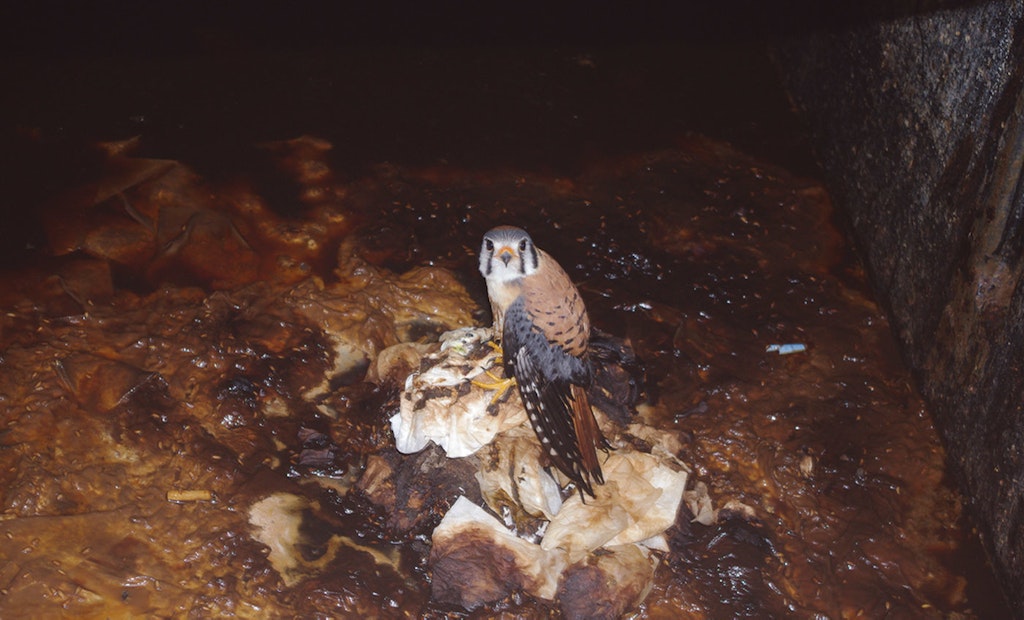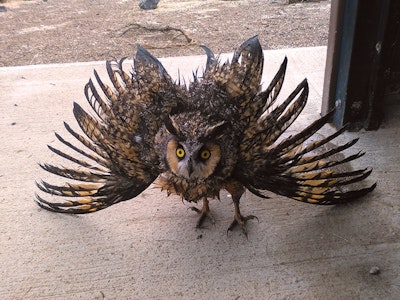
An American kestrel is stuck in a vault toilet in Elko, Nevada, before it is rescued. (Photo courtesy of U.S. Bureau of Land Management)
The distressing image of a cavity-nesting bird trapped at the bottom of a vault toilet pushed the folks at the Teton Raptor Center in Jackson Hole, Wyoming, to solve a shortcoming of pit toilets found in parks across North America and serviced by pumping companies.
The wildlife rehabilitation center receives several reports every year of wildlife becoming trapped in vault toilets, sometimes with fatal consequences and sometimes when they can make a rescue. Typically trapped are owls, kestrels (a type of falcon) and other birds that mistake the rooftop vent stack for a hollowed-out tree or fence post when looking for nesting sites. The birds enter the pipes and slide down into the tank, with no way to spread their wings and push themselves back up the slippery pipe walls.
Also, some types of waterfowl, reptiles, even raccoon and foxes have been trapped inside a tank full of waste. The foxes get there when snows are deep enough to cover the toilet structure roofs and then they fall down the hole, according to David Watson, development director for the Teton Raptor Center and its Poo-Poo Project coordinator.
CREATING A SCREEN
Several years ago, a photo was circulating on the internet of an owl stuck in the bottom of a vault toilet. A few of the center’s employees “jokingly said, ‘Why don’t we do something about this?’” Watson recalls. So the center with 10-12 employees located near the Grand Teton National Park, worked with a local company, Premier Powder Coating & Custom Fabrication, to design a protective screen that goes over the top of the 12-inch vents found on vault toilets.
To date, the nonprofit has sold nearly 14,000 screens through 500 partner organizations in the U.S., Canada and the Virgin Islands, bird-proofing many vault toilets found in national parks, forests and other wild places. All proceeds from the Poo-Poo Project, as it’s called, pay for the materials and the raptor center’s educational programming.
“It may seem strange (for the raptor center to manufacture and sell vent screens), but we want to do whatever we can to help the birds,” Watson says. “It’s great for the birds and it raises awareness for the wildlife entrapment issue, and we’re seen as a pretty innovative raptor center in the U.S.”
The 12-inch dished and screened steel cover has four flanges and self-tapping screws that fix it to the vent pipes, which are typically made of black plastic high-density polyethylene pipe. The flanges create a 3/4-inch opening around the top of the pipe to allow airflow even if the vent screens are covered with snow.
GETTING THE WORD OUT
The raptor center sells the screens directly to parks and wildlife protection groups. It also has a Sponsor-a-Screen Program where anyone can make a donation for a Poo-Poo screen, which is then installed where needed, and the donor receives a letter explaining where it was used to protect wildlife.
The raptor center has also found a big partner in the Missoula Concrete Construction, which has bought hundreds of screens and adds them for free to vaults they provide to customers across the country.
Adam Bauer, of the concrete manufacturing company, says he was occasionally getting reports from customers of birds being found in their vault tanks. It was concerning for Bauer, who wants his company to have a focus on the environment and protecting wildlife.
“This is something we thought about prior to knowing the raptor center existed and were in the process of designing our own screen when we found them,” Bauer says. “I decided that even though I could produce my own for less money, I would feel better about contributing toward the raptor center.”
Many pumpers are familiar with vault toilets and may have encountered trapped wildlife when pumping their holding tanks. The Missoula Concrete Construction vault toilets consist of a 1,000-gallon tank, which is 4 feet, 9 inches deep, topped by the restroom structure, also made of concrete, and held in place over the vault with a thick rubber seal.
Bauer was happy to partner with the nonprofit center. “I remember getting a call from the Forest Service and they said a bird found its way down there and died inside the vault; I said we should do something about that. Soon we found the raptor center and here we are today,” he says.
SEPTIC TANKS AND RESTROOM VENTS
The dangers of the vault toilet vents raise another issue. Could wildlife entrapment be an issue for smaller vents used in portable restrooms, or potentially even some septic or holding tank vents? Watson says that may be an issue, but the raptor center doesn’t have any specific evidence. However, he says smaller PVC pipes used to mark mining claims have been responsible for the deaths of thousands of songbirds in the West. These pipes are driven into the ground as markers, and Watson says they are similar in diameter and structure to portable restroom holding tank vent pipes.
“There have been instances where a pipe has been pulled out of the ground and there’s 50 dead birds laying there,” Watson says. The center is currently studying whether the vault screens could be made of a UV-protected plastic that would greatly reduce the cost to manufacture them, and Watson says a plastic screen could be scaled down for use in portable restrooms if wildlife entrapment is an issue.
For the time being, Watson says his group has its hands full trying to add screens to as many vault toilets as possible and wants to expand its reach to save more birds.
WHAT HAVE YOU SEEN?
So have you or your crew found wildlife trapped in a vault toilet, a septic or holding tank, or inside a portable restroom holding tank? Occasionally I’ve heard instances of a dog or other animals falling into an abandoned or open tank, but I haven’t heard any reports from pumpers about wildlife entrapment in vault toilets.








